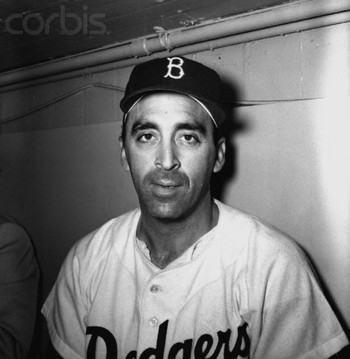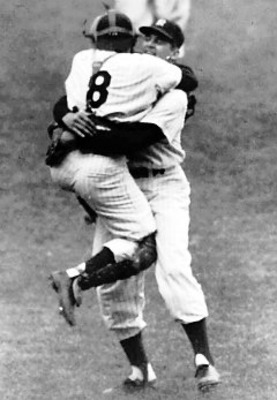Maglie may have reflected on the oddity of being in this position. It had been an odd season, truly surreal. It started in Spring Training when he was told he wasn't good enough to be a starter for the Cleveland Indians. He did his best to convince them he was good but try being sharp when you only pitch once a month. He begged Hank Greenberg, the General Manager, to play him, trade him release him, anything. Just give him a chance. So he got his chance. An exhibition game against a minor league team. Fortunately for Maglie he pitched great and fortunately for Greenberg, the Dodgers saw the performance. Looking for one last pitcher to help shore up the staff, the Dodgers took a chance and bought Maglie's contract. There was only one problem: Maglie hated the Dodgers with a passion and the feeling was mutual. Maglie pitching for the Dodgers would be today's equivalent of Jeter wearing red socks, a grey jersey and Boston written on the chest or Chipper Jones pulling on a red pin striped Phillies' uniform.
Photo Courtesy of: Bleacher Report
Once, while pitching for the Giants, Maglie threw a fastball at Carl "the Reading Rifle" Furillo's head. The next thing you know Furillo's in the Giant's dugout with Leo Durocher in a headlock. Durocher's turning purple, Giants players are telling Furillo to stop and the umpire's begging Furillo to kill Durocher. Total chaos and it all happened on the "Game of the Week" for the world to see. The Dodgers players nicknamed Maglie "the Barber" because he would pitch so close to your chin that he would give you a trim. The professional "do your job" culture that dominated the Brooklyn Dodgers of that era kept Furillo from killing Maglie when he walked into the Dodgers clubhouse and the 13-5 record he posted after arriving didn't hurt.
He wouldn't have questioned that his day was done as he left the mound. That's the thing about being a pitcher late in the game. If your spot in the order is due to bat the announcers refuse to even acknowledge you as an option. They'll say "the pitcher's spot is due up third" and you know late in the game your manager won't allow a .129 hitter to come to the plate when someone who is actually allowed to take batting practice can take your place. He had done his job and now his teammates had to do theirs.
This series was a crossroads moment in baseball history. It put the final stamp of historical interpretation on the era of to franchises. Since 1941 these two teams had met repeatedly in the World Series. In 1941, 1947, 1949, 1952 and 1953 it was always close, usually went six or seven games and provided some of the greatest World Series memories in history. This series would stamp the Dodgers as "lucky" to have finally gotten the 1955 win or stamp them as the new dynasty, defeating the aging, beaten, crumbling Yankees.
The top of the 9th started with Furillo, a consistent .300 hitter, flying out to right field. Campanella grounded to second for the second out and then came "the pitcher's spot". There was really no thought to the process. As unpredictable and random as this game can be this was inevitable and well planned out. There was one choice that made sense. The Dodgers needed a pinch hitter. A right handed batter was needed to face Don Larsen, the left handed pitcher. Preferably someone who had faced the pitcher before and knew his pitch pattern and his motion.
By about the 5th or 6th inning Dale Mitchell likely would have been thinking his name would come up if things kept going the way they were going. Sitting on the bench leaves a lot of time for thinking and observing and "what if...?"
The "what if" was here. Top of the ninth, 2 out the team is down 2-0, Game 5 of the 1956 World Series and, oh yeah, Don Larsen is pitching a perfect game. Mitchell likely thought "Don Larsen, of all people, is pitching a perfect game. For God's sake, they call him 'Googly Bird', and somehow not a single Brooklyn Dodger had reached base. If Pee Wee Reese, Jackie Robinson, Duke Snider, Carl Furillo, Gil Hodges and Roy Campanella can't get a hit off this guy, what do they expect me to do?"
Mitchell was a professional. He was in his tenth major league season and had told the Indians at the beginning of this year that it would be his last. It had been a great career: he had been on the Indians World Series champs team of 1948, had made great contributions to the 1954 juggernaut Indians that were shocked by the Giants, had made two All Star Games and had received MVP votes in 4 different seasons. Mitchell was a professional, a good one, and he knew what was coming. Go up there and start a rally.
Dale Mitchell struck out looking...and argued to the day he died that the pitch was high and outside. Replays are difficult to tell but he was probably right.This morning my friend asked me "if you were the last batter and the opposing pitcher is pitching a no hitter or perfect game, would you give up and let the guy have a no hitter, would you try to get a hit, or would you lay down a bunt and try to sneak a hit in there?" Basically, "If you were Dale Mitchell...?"
A no hitter or perfect game is a rare and amazing thing, but only if the pitcher earns it. Dale Mitchell may have struck out looking to give Don Larsen a perfect game but he didn't "GIVE" it to him. Mitchell's at bat was a 5 pitch struggle that ended on a questionable strike call. He didn't think "this guy is going to pitch a perfect game in the World Series" he thought "if I find a way to get on base I have the most powerful lineup in the world behind me and this guy will have forgotten about the 26 guys in a row he retired." I am also fairly certain that Sal Maglie wasn't thinking "I hope this guy gets it." He was thinking "if we can just get one guy on base we are still in this thing."
I'm not a pitcher so I can't say for sure but I doubt any pitcher would want to be given the last three outs of a no hitter. They would want to earn that achievement. In 1988 Dave Stieb, a pitcher for the Blue Jays took a no hitter into the 9th inning and with 2 strikes on the last batter gave up a hit. Devastating. It gets worse. One start later the same thing happened. It gets worse. In 1989 it happened again. Finally in September of 1990 Stieb got a no hitter. Imagine how great it must have felt for him to finally get that accomplishment and have earned it as opposed to having someone give it to him.
Photo Courtesy of: Sports Net
As a batter your job is to go from a batter to a base runner and help your team win the game. If you are lucky you will get four or five chances a game to make that happen and you can't give those chances up. Pitchers are creatures of habit and rely on a rhythm to be effective. If a pitcher is getting into a rhythm your best bet is to step out of the box as he is getting set to throw, take as much time as you can in between pitches and bunt. Make him come off the mound and force him to get out of rhythm. If you want a chance to win your best bet is to get him out of his rhythm early, by the third or fourth inning. If you're being no hit early in the game lay down a bunt. Rafael Furcal of the Cardinals is the best at this right now.
I can't tell you how many times I've watched a game where a pitcher is rolling along through the lineup and hitter after hitter is up there hacking at the first pitch popping up or grounding out. No one steps out of the box and makes the pitcher think a little. No one takes a pitch and makes the pitcher work to get you out. These situations in the 4th, 5th or 6th innings are where the pitchers really earn the no hitter or perfect game.
"If I were the last batter in a no hit game..." I'd fight to get a solid hit but I'd be screwed because my team didn't get the pitcher out of rhythm earlier in the game.



I'm with you. I'd try my best too because my team is depending on me, but then if I got a hit, I'd probably feel bad about messing up the no-hit game. Like you said though, the pitcher wouldn't want to be handed the no-hit game either so it really does come down to who wants it more.
ReplyDeleteGreat point: The pitcher doesn't want the "No-No" given to him. Never thought of that when I asked the question.
ReplyDeleteI was always the kind of sports fan that said "old is dumb and new is better". I never thought pre-1960s ball could be interesting. After reading your very well-written post, I may have to change my mind.
Keep up the good work...Here's an interesting question: Who's the best player to never have won a World Series?
jth
JTH- Thanks for the support. I know there are a lot of people who believe that older baseball is automatically boring. I am hoping my blog helps people fall in love with the history of the game and realize that baseball can be exciting even going back to the 1800's. I like the new question...stay tuned.
Delete